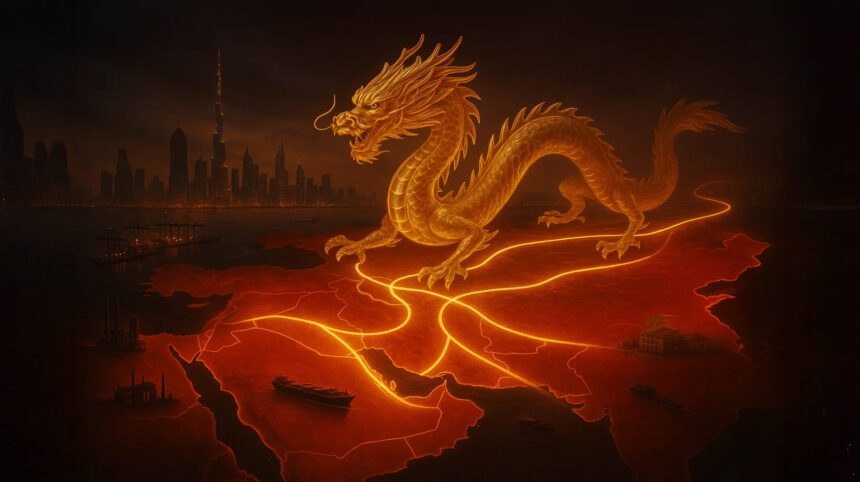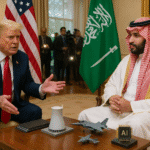Over the past decade, China has been quietly but steadily reshaping its footprint in the Middle East. What began as a primarily economic venture through its Belt and Road Initiative (BRI) has transformed into a multidimensional strategy encompassing diplomacy, infrastructure, and selective security engagement. Once a distant economic partner, Beijing now positions itself as a diplomatic broker and alternative power center in a region long dominated by the United States. This evolution marks not just a shift in China’s regional posture but a redefinition of how global influence operates in the 21st century.
China’s pivot toward the Middle East accelerated in the mid-2010s when it began to invest heavily in energy infrastructure, ports, railways, and digital networks across the region. The Gulf states, Iran, and parts of North Africa became central nodes in Beijing’s sprawling BRI network. Yet, China’s engagement today extends far beyond trade and construction. It reached a turning point in 2023 when Beijing successfully brokered the Saudi-Iran rapprochement, a diplomatic breakthrough that surprised even seasoned observers. Since then, China has hosted peace envoys for the Israel-Palestine conflict and joined naval exercises with Iran and Russia in the Gulf of Oman. These moves signal that Beijing no longer confines itself to the role of a trading partner; it seeks to be a political stabilizer and a security stakeholder.
The motivations behind China’s expanding role are both practical and strategic. Energy security remains paramount; China is the world’s largest importer of oil, and a significant portion of its supply originates in the Gulf. Ensuring stable access to these resources and securing alternative maritime routes has become a core national interest. Economic leverage is another driver. By financing and building critical infrastructure under the BRI, China creates long-term dependencies and influence across the Middle East and North Africa. On the diplomatic front, Beijing’s ambition is to present itself as a responsible global power, a contrast to what it portrays as the interventionist and often destabilizing approach of the United States. Its messaging emphasizes sovereignty, non-interference, and mutual development, appealing to regional governments weary of Western conditionality.
China’s strategy in the Middle East is defined by restraint and pragmatism. It avoids military entanglements and prefers influence through commerce, diplomacy, and technology. Even in the Saudi-Iran deal, China acted as a convenor rather than an enforcer. Its response to flashpoints such as the Israel-Iran tensions or Gaza conflicts has been characterized by “positive neutrality,” calling for calm and dialogue without taking sides. At the same time, Beijing has quietly deepened defense and technology cooperation with several states. It has sold surveillance systems to Gulf monarchies, conducted joint naval drills with Iran and Russia, and supplied drones and cyber-infrastructure to regional clients. Still, China’s approach remains cautious; it understands that overextension could jeopardize its domestic stability and core interests in the Indo-Pacific.
The implications of China’s expanding role are far-reaching. For Middle Eastern nations, Beijing offers an attractive alternative to the West, an economic partner that refrains from lecturing on democracy or human rights. Gulf states, particularly Saudi Arabia and the UAE, have leveraged their ties with China to diversify strategic options while maintaining security relations with the U.S. Iran, on the other hand, views China as a crucial economic lifeline in the face of Western sanctions, though Beijing’s reluctance to back Tehran during crises has exposed the transactional nature of their partnership.
For the United States, China’s growing influence poses both a symbolic and strategic challenge. Washington’s dominance in the Middle East is not immediately threatened; its military presence, alliances, and defense sales still far outpace Beijing’s reach, but China’s approach chips away at the U.S. narrative of indispensability. American policymakers risk overreacting by viewing every Chinese initiative as a zero-sum threat. Analysts caution that competing with China in the Middle East could distract Washington from its core priorities in Asia, inadvertently playing into Beijing’s hands.
At a global level, China’s engagement reinforces the narrative of an emerging multipolar world. Beijing’s balancing act supporting Iran while investing heavily in Gulf states, advocating for Palestine while trading with Israel, positions it as a flexible interlocutor capable of dealing with all sides. Yet, this very flexibility also highlights its limitations: China wants influence without the burden of commitment. Its success will depend on whether it can sustain this delicate equilibrium in a region where alliances are fluid and crises are constant.
In the end, China’s expanding presence in the Middle East is less about replacing the U.S. than about redefining power itself. It reflects Beijing’s belief that influence in the 21st century is built not through occupation or ideology, but through connectivity, capital, and quiet diplomacy. Whether this strategy endures will depend on how well China manages the contradictions of being both a cautious trader and an aspiring great power in one of the world’s most volatile regions.
















